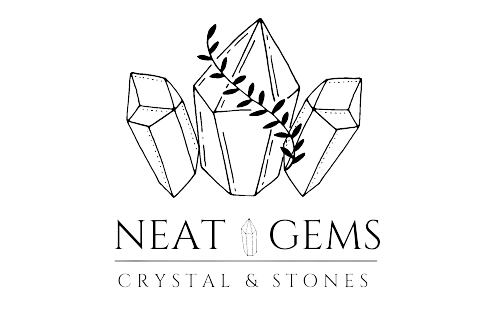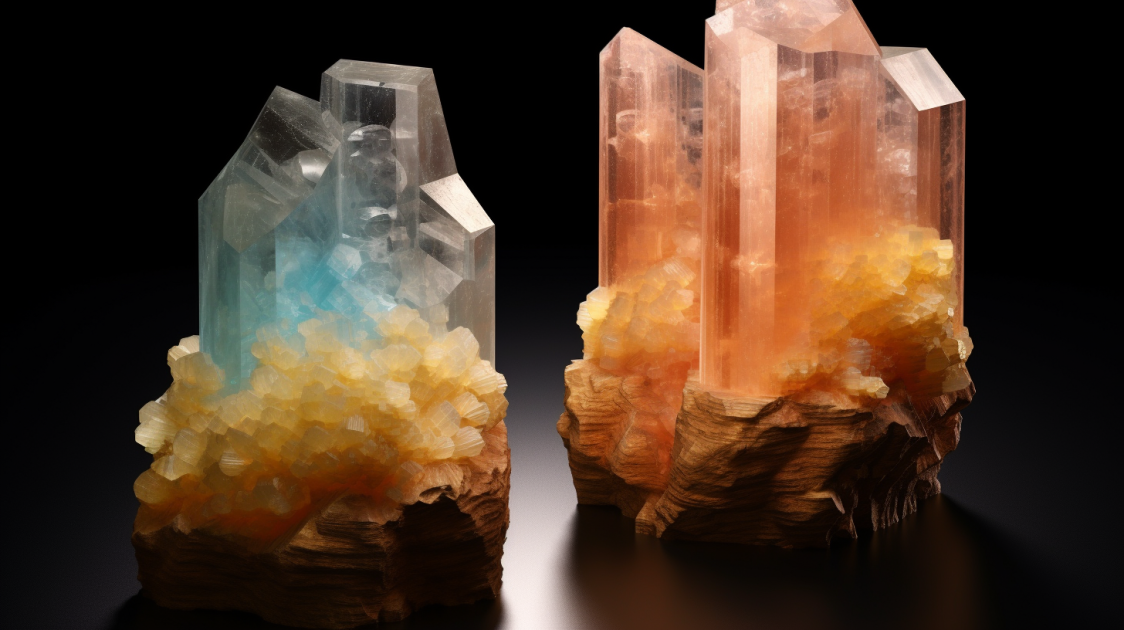Have you ever heard of calcite and aragonite? If so, you may be wondering what the differences are between these two crystal cousins. Many people believe that these crystals possess supernatural powers, but is this true? In this article, we’re going to take a deep dive into the world of calcite and aragonite to find out how they differ from one another. We’ll explore their physical characteristics, chemical composition, occurrences in nature, uses in everyday life as well as potential health benefits. Get ready to discover the power that lies within these mysterious stones and learn about why they have been revered by many cultures for centuries!
Key Takeaways
- Calcite and aragonite are two crystal cousins with unique physical and chemical properties.
- Calcite softens water while aragonite’s dissolution increases acidity levels in water.
- Calcite is found in sedimentary rock formations, while aragonite forms under high-pressure conditions and can be found near deep-sea hydrothermal vents or coral reefs.
- Both minerals offer potential health benefits, including detoxification properties and healing benefits.
Overview of Calcite and Aragonite
You’ll be amazed to learn of the fascinating relationship between calcite and aragonite! These crystal cousins are closely related, yet they have unique properties that make them stand out. Calcite and aragonite share a common biological formation – both form in seawater, lakes, and other bodies of water. However, their environmental impacts differ significantly. Calcite is known for its ability to soften water by precipitating calcium carbonate from it, while aragonite’s dissolution has been found to increase acidity levels in waters. The result? An interesting dynamic between these two crystal cousins that affects ecosystems all over the world!
The physical characteristics of calcite and aragonite also set them apart. Both have distinct shapes; calcite appears as rhombohedrons or scalenohedrons while aragonites may take on an orthorhombic shape or a tubular formation. They also differ in hardness – calcite comes in at 3 on the Mohs scale whereas aragonites measure around 4-4.5 on the same scale. Get familiar with how these crystal cousins look and feel: it will help you identify them more easily!
Physical Characteristics
Discovering the differences in physical characteristics between these two crystal cousins can help you pick the right one for your needs. Both calcite and aragonite are both composed of calcium carbonate, but they have different crystal structures, which influences their hardness and other characteristics.
To begin with, calcite has a rhombohedral or trigonal crystal structure that makes it softer than aragonite. This means that it is more susceptible to scratches and other damage. On the other hand, aragonite has an orthorhombic crystal structure that makes it harder than calcite. This gives it greater durability and resistance to scratching and abrasion. In addition, by comparing the two crystals side by side, you will see that aragonite tends to be darker in color while calcite is usually lighter.
These distinct physical characteristics between calcite and aragonite make them ideal for various uses: from jewelry making to rock tumbling applications, each crystal cousin offers unique advantages depending on your needs. Understanding their differences in hardness as well as their respective crystalline structures can help you decide which one fits best for your project or application. Knowing this information will empower you to confidently select the appropriate material for whatever purpose you have in mind.
Chemical Composition
Both calcite and aragonite have the same chemical composition of calcium carbonate, but their distinct crystal structures can make them behave differently in various situations. This is because they are formed from different molecular arrangements, which result in varying crystal formations. For instance, calcite has a trigonal crystalline structure that allows for more flexibility than aragonite’s orthorhombic structure. As a result, these two minerals react differently to certain environmental conditions such as temperature and pressure. In addition to this, the variations in their molecular arrangements also contribute to their distinct physical properties like hardness and solubility.
These two mineral cousins may possess similar chemical compositions, but they are far from identical when it comes to their molecular structures and crystal formations. This helps explain why they react differently under certain circumstances and have diverse physical characteristics. Moving forward, let’s take a look at where these minerals occur naturally in the world around us.
Occurrences in Nature
Experience the fascinating differences between calcite and aragonite by taking a look at where they occur in nature. Both crystals form in the same kind of environment, but each has its own special characteristics:
- Calcite is found in sedimentary rock formations, making it more commonly available than aragonite.
- Aragonite forms under high-pressure conditions and can be found near deep-sea hydrothermal vents or coral reefs.
- Both calcite and aragonite are involved in fossil preservation, as these crystals may form around organic matter.
- Crystal formation can take place over a long period of time or instantaneously due to certain environmental conditions.
These crystal cousins have very different occurrences in nature; understanding this fact will give you an edge on your journey to power! Plus, learning about their uses in everyday life is just one step away!
Uses in Everyday Life
You’ll be amazed at how calcite and aragonite can be used in your everyday life! Both of these crystal cousins have a wide variety of uses, from jewelry-making to crafting. Calcite is often used in making sculptures, ornaments, and even furniture due to its malleability. Aragonite is softer than calcite but still popular for use in jewelry-making because of its attractive colors and unique shapes. Whether you’re creating a bracelet or necklaces, aragonite makes a great addition to any piece. The ability to manipulate these crystals into a variety of shapes means they can also be used for carving and engraving. With their beauty and versatility, it’s no wonder that both calcite and aragonite are commonly found in craft projects.
As if that weren’t enough, both minerals offer potential health benefits too. In fact, certain types of quartz crystals are thought to bring balance and harmony into the environment around them–so next time you’re looking for something special to add to your home decor, why not try some form of calcite or aragonite? You may just find yourself feeling more relaxed and energized after adding these crystals into your life. Now let’s explore the potential health benefits these two crystal cousins could bring!
Potential Health Benefits
It is well known that calcite and aragonite have many practical uses in everyday life, but did you know they may also offer potential health benefits? From detoxification properties to healing benefits, these crystal cousins can work wonders for your wellbeing. Here are just a few of the potential advantages of using calcite and aragonite:
- Detoxification Properties:
- Calcite is said to help remove toxins from the body by raising its pH level, thus allowing it to be more alkaline.
- Aragonite can absorb negative energies and replace them with positive vibrations, which helps your body rid itself of any stagnant energy or psychological blockages.
- Healing Benefits:
- Calcite has been used as a remedy for physical ailments such as digestive issues and respiratory difficulties.
- Aragonite helps improve mental clarity and focus due to its calming nature. It also assists with stress reduction, making it an ideal choice for those looking to better manage their emotions.
Conclusion
You’ve learned all about calcite and aragonite, their physical characteristics, chemical composition, natural occurrences, and uses in everyday life. Plus, you know they can provide potential health benefits. With this comprehensive guide to these crystal cousins, you have a better understanding of them and how each is unique. Through the use of personification—calling these stones “crystal cousins”—you now see them as more than just minerals; they are part of your world! The next time you come across either one of these beautiful crystals or products that contain them, you can appreciate it with newfound knowledge.
Q: What is the difference between calcite and aragonite?
A: Calcite and aragonite are both carbonate minerals composed of calcium carbonate, but they have different crystal structures. Aragonite crystals have a more complex structure than calcite crystals, and they also have different physical properties.
Q: Are calcite and aragonite commonly found in rocks?
A: Yes, both calcite and aragonite are commonly found in sedimentary rocks such as limestone and marble. Calcite is often the dominant mineral in these rocks, while aragonite is also present but less common.
Q: What are some of the properties of calcite?
A: Calcite is a colorless mineral that has a vitreous or glassy luster. It has a Mohs hardness of 3.5, which means it is relatively soft and can be scratched by a copper penny. Calcite has a specific gravity of 2.71, and it cleaves in three directions to form rhombohedrons.
Q: How is calcite used?
A: Calcite is used in a variety of ways, including as a source of calcium for cement, as a chemical feedstock for the manufacture of lime, and as a flux in the smelting of metallic ores. It is also used as a decorative stone and in the production of optical instruments and lenses.
Q: What is the chemical formula for calcite?
A: The chemical formula for calcite is CaCO3, which means it is composed of one calcium atom, one carbon atom, and three oxygen atoms.
Q: Do aragonite and calcite have similar properties?
A: Aragonite and calcite have similar chemical compositions, but they have different crystal structures and physical properties. Aragonite is slightly harder than calcite, with a Mohs hardness of 3.5 to 4, and it has a higher specific gravity than calcite. Aragonite is also more likely to dissolve in acid than calcite.
Q: How is aragonite used?
A: Aragonite is used as a source of calcium in fertilizer, as a raw material for the production of cement, and as a gemstone. It is also used in aquariums as a substrate, since it can be dissolved by acidic water and used by plants and animals in the aquarium.
Q: What is a polymorph of calcium carbonate?
A: A polymorph of calcium carbonate is a mineral that has the same chemical formula as another mineral (in this case, CaCO3), but a different crystal structure. Calcite and aragonite are polymorphs of calcium carbonate, as are vaterite and polymorph B.
Q: Where do shells of marine organisms come from?
A: Shells of marine organisms are composed of calcium carbonate that is produced by the organisms themselves. For example, mollusks such as clams and snails form their shells by secreting calcium carbonate from the mantle tissue.
Q: What is the difference between calcite and dolomite?
A: Calcite and dolomite are both carbonate minerals composed of calcium magnesium carbonate, but they have different crystal structures. Calcite is a rhombohedral crystal, while dolomite has a trigonal crystal structure.


Leave a Reply